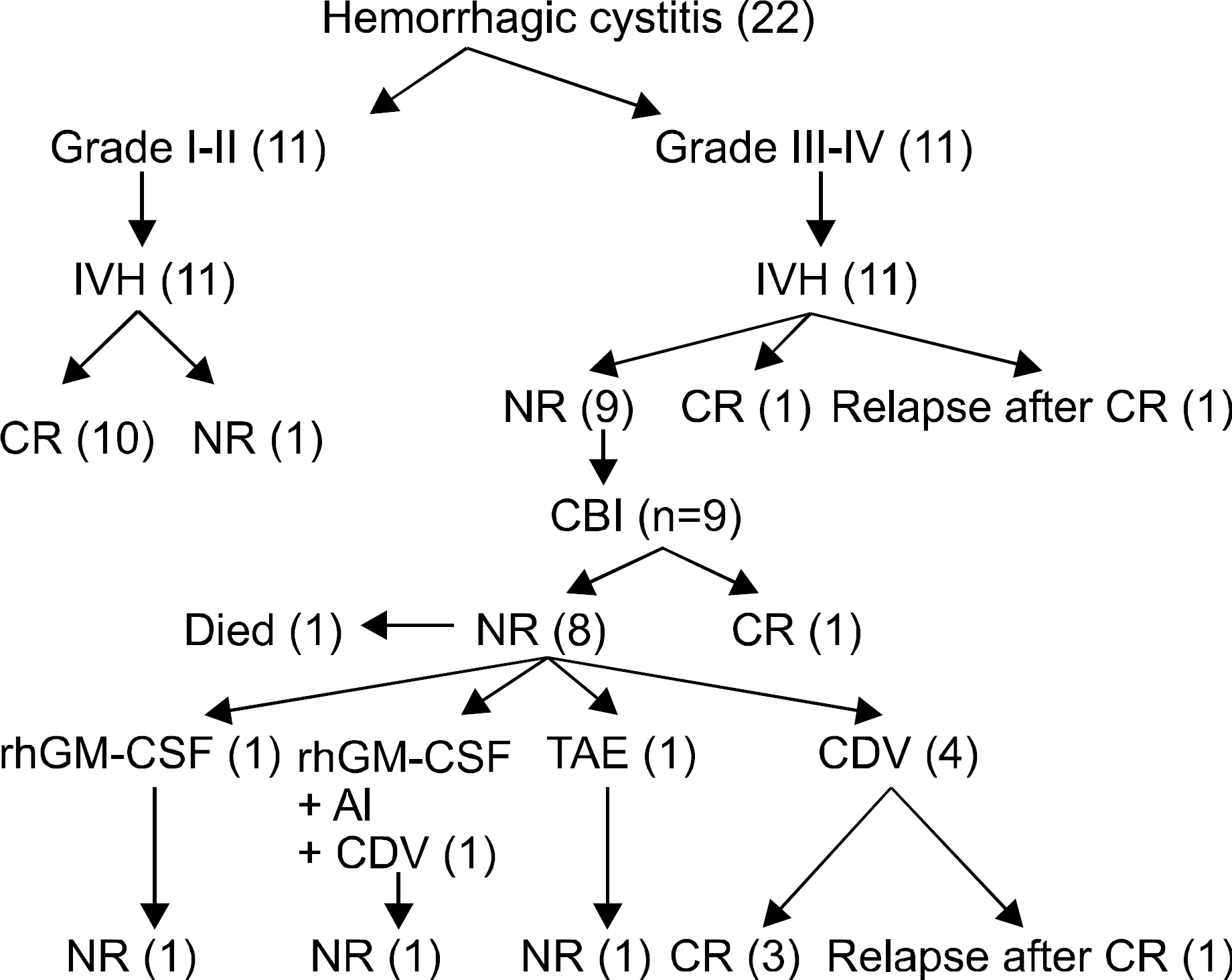1). Gorczynska E., Turkiewicz D., Rybka K, et al. Incidence, clinical outcome, and management of virus-induced hemorrhagic cystitis in children and adolescents after allogeneic hematopoietic cell transplantation. Biol Blood Marrow Transplant. 2005. 11:797–804.

2). El-Zimaity M., Saliba R., Chan K, et al. Hemorrhagic cystitis after allogeneic hematopoietic stem cell transplantation: donor type matters. Blood. 2004. 103:4674–80.

3). Yamamoto R., Kusumi E., Kami M, et al. Late hemorrhagic cystitis after reduced-intensity hematopoietic stem cell transplantation (RIST). Bone Marrow Transplant. 2003. 32:1089–95.

4). Leung AY., Yuen KY., Kwong YL. Polyoma BK virus and haemorrhagic cystitis in haematopoietic stem cell transplantation: a changing paradigm. Bone Marrow Transplant. 2005. 36:929–37.

5). Palandri F., Bonifazi F., Rossi C, et al. Successful treatment of severe hemorrhagic cystitis with selective vesical artery embolization. Bone Marrow Transplant. 2005. 35:529–30.

6). Gine E., Rovira M., Real I, et al. Successful treatment of severe hemorrhagic cystitis after hemopoietic cell transplantation by selective embolization of the vesical arteries. Bone Marrow Transplant. 2003. 31:923–5.

7). Dorticos E., Pavon V., Jaime JC, et al. Successful application of epidermal growth factor for treatment of hemorrhagic cystitis after bone marrow transplantation. Bone Marrow Transplant. 2003. 31:615–6.

8). Arthur RR., Shah KV., Baust SJ., Santos GW., Saral R. Association of BK viruria with hemorrhagic cystitis in recipients of bone marrow transplants. N Engl J Med. 1986. 315:230–4.

9). Arthur RR., Shah KV., Charache P., Saral R. BK and JC virus infections in recipients of bone marrow transplants. J Infect Dis. 1988. 158:563–9.

10). Apperley JF., Rice SJ., Bishop JA, et al. Late-onset hemorrhagic cystitis associated with urinary excretion of polyomaviruses after bone marrow transplantation. Transplantation. 1987. 43:108–12.
11). Bielorai B., Shulman LM., Rechavi G., Toren A. CMV reactivation induced BK virus-associated late onset hemorrhagic cystitis after peripheral blood stem cell transplantation. Bone Marrow Transplant. 2001. 28:613–4.

12). Akiyama H., Kurosu T., Sakashita C, et al. Adenovirus is a key pathogen in hemorrhagic cystitis associated with bone marrow transplantation. Clin Infect Dis. 2001. 32:1325–30.

13). Fedele CG., Ciardi M., Delia S., Echevarria JM., Tenorio A. Multiplex polymerase chain reaction for the simultaneous detection and typing of polyomavirus JC, BK and SV40 DNA in clinical samples. J Virol Methods. 1999. 82:137–44.

14). Yamamoto AY., Mussi-Pinhata MM., Pinto PC., Figueiredo LT., Jorge SM. Usefulness of blood and urine samples collected on filter paper in detecting cytomegalovirus by the polymerase chain reaction technique. J Virol Methods. 2001. 97:159–64.

15). Held TK., Biel SS., Nitsche A, et al. Treatment of BK virus-associated hemorrhagic cystitis and simultaneous CMV reactivation with cidofovir. Bone Marrow Transplant. 2000. 26:347–50.

16). Leung AY., Suen CK., Lie AK., Liang RH., Yuen KY., Kwong YL. Quantification of polyoma BK viruria in hemorrhagic cystitis complicating bone marrow transplantation. Blood. 2001. 98:1971–8.

17). Lee GW., Lee JH., Choi SJ, et al. Hemorrhagic cystitis following allogeneic hematopoietic cell transplantation. J Korean Med Sci. 2003. 18:191–5.

18). Heath JA., Mishra S., Mitchell S., Waters KD., Tiedemann K. Estrogen as treatment of hemorrhagic cystitis in children and adolescents undergoing bone marrow transplantation. Bone Marrow Transplant. 2006. 37:523–6.

19). Ordemann R., Naumann R., Geissler G., Bornhauser M., Schuler U., Ehninger G. Encouraging results in the treatment of haemorrhagic cystitis with estrogen - report of 10 cases and review of the literature. Bone Marrow Transplant. 2000. 25:981–5.

20). Alrabiah FA., Sacks SL. New antiherpesvirus agents. Their targets and therapeutic potential. Drugs. 1996. 52:17–32.
21). Lea AP., Bryson HM. Cidofovir. Drugs. 1996. 52:225–30.

22). Gonzalez-Fraile MI., Canizo C., Caballero D, et al. Cidofovir treatment of human polyomavirus- associated acute haemorrhagic cystitis. Transpl Infect Dis. 2001. 3:44–6.





 PDF
PDF ePub
ePub Citation
Citation Print
Print


 XML Download
XML Download